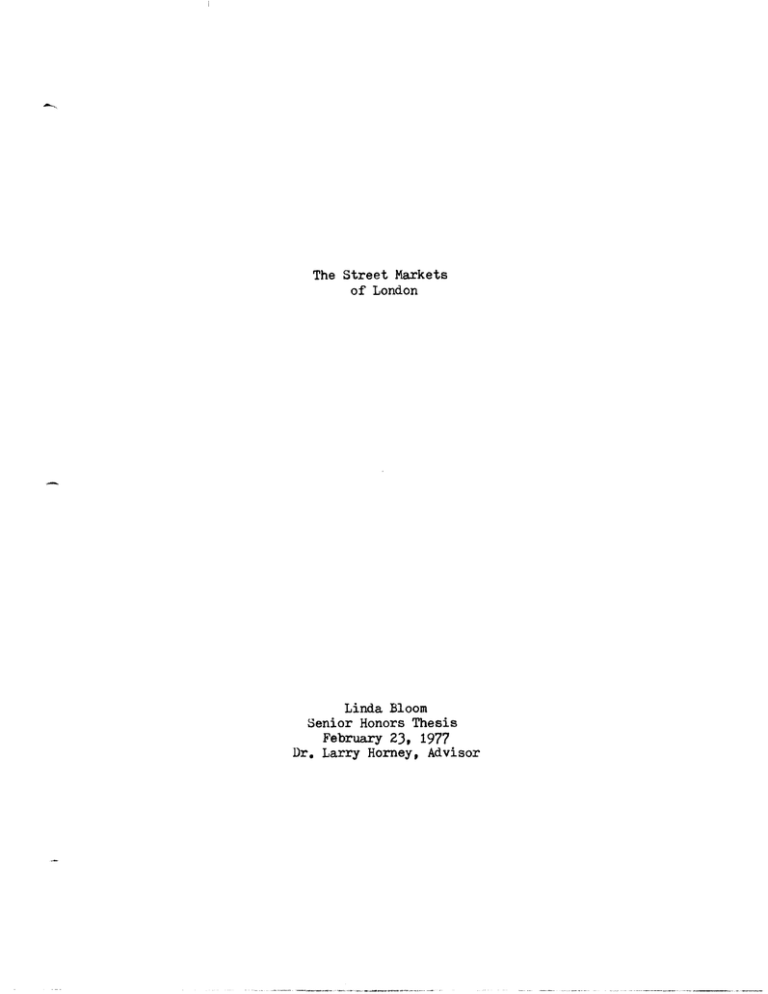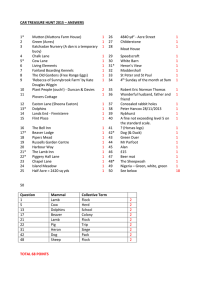1977 The Street Markets of London Linda Bloom
advertisement

The Street Markets of London Linda Bloom Senior Honors Thesis February 2), 1977 Dr. Larry Horney, Advisor ~i~\\ \\\eS 1C) Lb ';;)4'6 J .1-.u \ C4-1-' , ' J ,B~:~ Preface The Industrial Revolution heralded the advent of street markets in England as traders brought their goods to towns whose inhabitants were no longer self-supporting. At first, anyone was welcome to ply his wares on the town pavements. Then, as the sellers began to construct stalls to hold and display their goods, they became subject to license and size regulations. By 1936, London supported over 100 street markets of varying size and content. Road, Petticoat Lane and Leather Lane. Portobl~llo E~ch The more popular markets included of these three markets assumes a different atmosphere. Leather Lane remains closest to the concept of the neighborhood. market. this Tucked behind a narrow alley off a main thoroughfare, ~~ket is frequented by local inhabitants browsing and doing daily shopping. Fortunately, the area has not yet become an integral part of the London tourist business. Portobello Road and Petticoat Lane receive the largest influx of tourists of all the London markets, but each has its own distinctions. Portobello Road still retains somewhat of an artsy, avant garde flavor and a diminished reputation as an .antique market. Petticoat Lane caters almost exclusively to the tourist trade, supplying general merchandise with a heavy emphasis on clothing. 1 2 The excitement, the novelty and the individuality of these three markets comprise the subject of the following essay, expressed in words and photographs. The words are for explanation, color and dialogue; the pictures for illustration, mood and atmosphere. Most of the content deals with people··-the people who buy, the people who sell, the interaction of the crowd, the variety of personalities and archetypes, the vast numbers of humanity who trample the streets. Introduction The crowd joustles like a herd of amiable cows down the narrow street, lined on both sides with an architectural variety of homemade wooden stalls. Drawn by a promising sign, attractive display or persuasive seller, they ramble from one booth to another, examining quantities of clothing, food, household items and other guaranteed bargains. At one stall, a Frenchman tries to argue down the price of a leather jacket with its uncompromising Indiam owner; at another, an indignant housewife demands a refund for a faulty kitchen gadget; at yet another, an American tourist happily shells out pounds and pence for a stat.ue of Big Ben to the stall-keeper with the charming Cockney accent. No better place in London offers a more comprehensive intera.ction with its inhabitants and visitors than the street markets located in various areas throughout the city. Within a few blocks, the English, the growing international population and the continual influx of tourists congeal into a mass united by density and a common quest for the increasingly elusive bargain. And the stall-keepers, ranging from Eliza Doolittles and colorful remnants of the '60s to experienced, hard-nosed sellers and jovial crowdpleasers, manage to supply almost anything outside of the Holy Grail. Housewives search for household goods, inspect the numerous fruit and vegetable booths and buy shampoo and toothpaste at 3 4 discount prices. Young people compare merchandise at competing blue jeans stalls, look for bargain record albums and comb through piles of cheap jeiirelry. Businessmen pause at stands featuring belts and shoes, ponder over the authenticity of a leather coat and watch a demonstration at the hardware booth. Children stare tn fascination as the toy salesman produces his wares. Tourists, hungry for souvenirs, gaze eagerly at stalls rimmed with the Union Jack, offering the usual array of ashtrays, tea towels and mugs depicting Westminster Abbey, st. Paul's and Touer Bridge. Innumerable booths display books, flowers, clothing, novelty items, suitcases, authentic and not-soauthentic antiques, furniture, umbrellas, radios and tape recorders, fast foods and other miscellaneous items. "Genuine leather!" booms a voice at one end of the street. "Get yer fresh vegetables here t" chimes in another. look at these bargains!" adds a third voice. blend into a sort of salesmen's symphony. "Come and Together they From pianissimo to fortissimo, the blend of sales pitches sometimes rises into an unimaginable harmony, whether the staccato "farm eggs!" of the dairyman's wife or the legato "Try this soap and you III be making the wisest buy of the day" from the dealer of sundries. Trying to please the disgruntled and persuade the miserly is part of the stall-keeper's art. Often a seller will draw a small crowd while elaborately expounding upon the virtues of a certain product. The real crowdpleasers are those with an air of showmanship, making their sales pitch an amusing entertaihment. Leather Lane While the bigger markets are often overrun with tourists, Leather Lane patrons are usually the working class inhabitants of the city. Here, the casual shopper is more likely to encounter the British housewife chatting cheerfully with a bespect~cled vegetable man as she selacts carrots for stew, the sh()p girl wistfully speculating over the dress racks, the tradesman carefully examining a selection as he listens to the seller's anxious guarantees and the vagrant, cautiously eyeing the a~indoned stalls and searching empty boxes. It is not the merchandise that is of interest in Leather Lane, but the people who buy and sell it. The entrace is as inconspicious as the market itself. A narrow alley off Holborn appears to be deserted except for a young man standing near a rack of ties. But a couple of blocks down, the cries of the vendors become audible and the main stalls appear, rimming a thoroughfare of shoppers. 'fhe traffic begins. "They show a lot of rubbish down 'ere," says one man to another as he surveys the long rows of merchandise. "Nothing's cheap." "Unless you're really lucky," the other replies. But they do buy, despite the cost, despite the bargain basement quality. They buyout of necessity. necessities are luxuries. 5 And even some 6 "'This is a nice stall," remarks a young woman to her friend as they approach racks of clothes. OJI like the dresses here." HE!r friend is bitter. "It's so expensive here, it's criminal." Dreaming of a new addition to her wardrobe, the young woman does not hear her friend's reply. "I like this one," she says softly, giving the material a loving caress. But her friend is right, the dress is too expensive for her budget. They reluctantly move to the next booth as the stall-keeper, wearing a tape measure around his neck, calls after them, "Anybody else want serving here, girls?" "These styles are !.4.50, 1uv," a salesman telis the woman whose attention is focused upon a green sweater. "These are f,J.90," he adds encouragingly, pointing to an adjacent rack. Another vendor attempts to be more persuasive. Catching the eye of a young passerby, the old man pleads, "Come up here, luv. Come up here, my darling." Evidently uninterested in his merchandise, she chooses to walk away instead. Near the front of the market, a stall-keeper sells his miscellaneous junk with the finesse of an experienced aucttiboneer, maintaining a rather large audience around him, much to the dismay of his neighbors, whose own stalls are blocked from view. If he can't sell one item, he quickly moves to the next, insuring continual consumer interest and steady profits • .Down the street, a salesman personally demonstrates the efficency of his ironing pads to curious customers. English eggs, "fresh from the farm," are given prominent display at 7 a neighboring booth. Another stall-keeper launches into his well-versed "you can't get a better deal anywhere" speech. Satisfaction is not guaranteed. An angry woman berates a very short old man in a brown suit at the curtain stall. "I just bought this curtain and find it is eight inches shorter than the other," she complains loudly. This is not a fair weather crowd. As persistant as the postman making his appointed rounds, the stall-keepers subject themselves to the whims of the weather in order to realize a livelihood. They stamp their feet, bounce around briskly and rub numbed hands together to counteract the damp, chill wind. Not everyone manages to maintain a brave front. One long-haired clerk in jeans and a brown coat is frankly miserable as she shivers amid the sweaters of her stall. Va.grants are not well tolerated; perhaps because so many of these people are barely able to scrape out an existance themselves. Upon seeing a shabbily-dressed man hesitantly scooping up a few rotten vegetables from a deserted booth, a nearby stall-keeper chases the startled bum away, his insults pursuing the man down the street. "Ten each, large cues," shouts the vegetable man. Petticoat Lane The mass of humanity crammed into the narrow streets of the Petticoat La.ne market is reminiscent of a crowd scene from a Cecil B. DeMille film epic. Struggling to get from one booth to another without being swept past by the undercurrent of shuffling feet is barely worth the energy expounded. Customers who arrive early enough at this Sunday morning market have a chance to explore the small network of streets of which it is composed, the chief one being Bishopsgate, before being assaulted by a multitude of foreign visitors. Petticoat Lane is a tourist market. No sane Englishman or woman would disturb their Sunday peace to be joustled by a Pakistani, trampled upon by an Italian or berated by a Frenchman. The density of the crowd increases in proportion to the height of the sun; by mid-morning, the streets have reached squeezing capacity. A spectrum of underwear boldly adorns one stall. Checked, flowered, polka-dotted, paisley, cartoon; satin, lace, cotton; bikini, boxer; ladies, men's, boys, girls--the variety is mind-boggling. Few of the curious, however, are willing to risk embarassment by visiting the gauche display. The stall-keeper stands stern+y nearby, his expression daring anyone to laugh at his wares. 12 13 Inexpensive clothes abound. A partially enclosed square barsains in jeans, cheesecloth shirts and other apparel, house~) constj, tuting one of Pet ticoa t Lane t s most at tracti ve qualities. In thE~ absence of dressing rooms, girls slip on skirts over jeans and sweaters over shirts, comparing sizes. A quick flick of the ever present measuring tape allows the vendor to swiftly assess the waist measurements of a slim teenager or buxom matron. Across the road, an argument between a woman and the beardE~d seller of coats for L12.99 elicits mild attention from nearby shoppers. delibl:lrations. But they soon return to their own Some tryon the gaudy necklaces hanging in strands from stall rafte!J's; some sort through quantities of folding umbrellas, a London necessity; others investigate guaranteed Swiss watches for L3.95. 'rhe stall-keepers assume a slightly different attitude here. Shrewdly sizing up gullible customers, the innocents abro~i, they badger, coo and cajole their way to successful sales. Sooner or later, someone will find that garish ashtray depicting Queen Elizabeth II irresistable. "Mind yer legs!11 shouts an old man who deftly weaves a cart of hot coals through the crowd to a chestnut stand. Onlookers watch him quickly transfer the coals under the grill supporting the roasting nuts. The constant pressure of the crowd prohibits any hopes of lingering long. After selecting a few bargains, the average shoPP'9r is quite happy to fight to an exi t, embracing the emptiness of the outside streets with package-laden arms.





